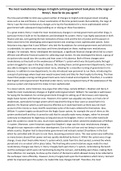The most revolutionary changes in English central government took place in the reign of
Henry I. How far do you agree?
The time period 1066 to 1216 saw a great number of changes to English central government including
areas such as law and finance. A closer examination of the time period reveals that evidently, the reign of
Henry I saw the most revolutionary changes as he lay the foundations for a more sophisticated central
government with subsequent kings building on or relying on these foundations.
To a great extent, Henry I made the most revolutionary changes in central government and other kings, in
particular Henry II built on his foundations and developed his system. Henry I was highly passionate in both
finance and law, even gaining the two nicknames of beau clerk and the lion of justice and his passion in
these areas led to him developing central government and creating a more sophisticated system. Some
historians may argue that it was William I who laid the foundations for central government and whilst this
is undeniable, his system was very basic and Henry developed on these, making more revolutionary
changes. For example, Henry I developed the exchequer, a significant financial change which led to a more
efficient and effective financial system for collecting royal monies. He also developed the bench, a group of
six justices who would tour the country and hear cases in his absence. Both of these changes were
revolutionary as they built on the weaknesses of William I’s system which was that particularly the legal
system struggled to cope in the king’s absence. By creating these central government departments, Henry I
was able to delegate to central government more, allowing for a smoother running of government in his
absence. In addition to new departments, he also introduced new personnel to run them, introducing the
concept of patronage where loyal men would receive lands and titles for their loyalty to the king. This then
meant that people running central government were more trained and competent. Therefore, it is evident
that English central government flourished under Henry I as he recognised many of the weaknesses of the
previous system and improved it to make it more sophisticated.
To a lesser extent, some historians may argue that other kings, namely William I, Stephen and Henry II
made the most revolutionary changes in English central government. William I for example is well known
for laying the foundations for central government through his setting up of the treasury and replacing
Anglo-Saxon barons with Norman ones. However, this system was arguably very basic as it had a lot of
weaknesses, particularly his legal system which required the king to hear cases so would halt in his
absence. His financial system as well was less effective as it could have been as there was not much
account of the money so many sheriffs would take some of the taxes collected for themselves. Also,
William I’s system largely continued from the Anglo-Saxon system, for example the use of shires as this
system worked well and thus it cannot be said that he actually made many changes, rather he stressed
continuity to emphasise his legitimacy as king and secure his kingdom. Henry I on the other hand built
upon this system to create his own, much more sophisticated one which solved the weaknesses of William
I’s system. Moreover, some historians argue that Stephen’s reign saw the most revolutionary changes,
though this was regression rather than development. Due to the civil war and not being in control of the
whole country, Stephen had to decentralise government and instead created 20 earldoms in the East
which he controlled with 20 earls to rule them, becoming provincial rulers. This new system was ineffective
as many barons abused their power and was quickly abolished by Henry II. Whilst this system was a huge
change, it was short lived unlike Henry I’s system which, aside from this short period, survived the whole
period and is to an extent still in place today. The final king who some historians argue made the most
revolutionary changes was Henry II. Henry II largely built upon Henry I’s system, reintroducing the bench
and the exchequer which were not functioning during the civil war, and building upon these, making them
more effective. For example, he drew up the charter of the barons which allowed money to be collected to
the exchequer more efficiently. However, Henry II largely built upon the foundations which Henry I laid and
whilst he improved upon this system, he made little new changes himself. Therefore, the most




